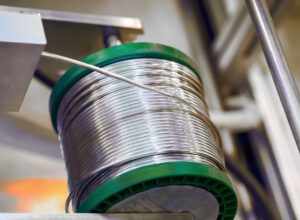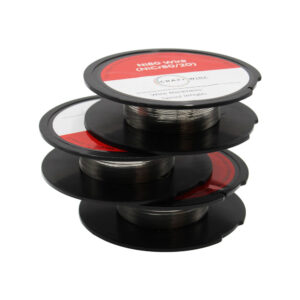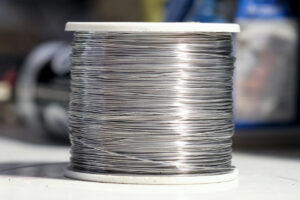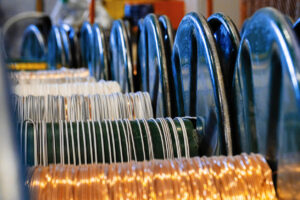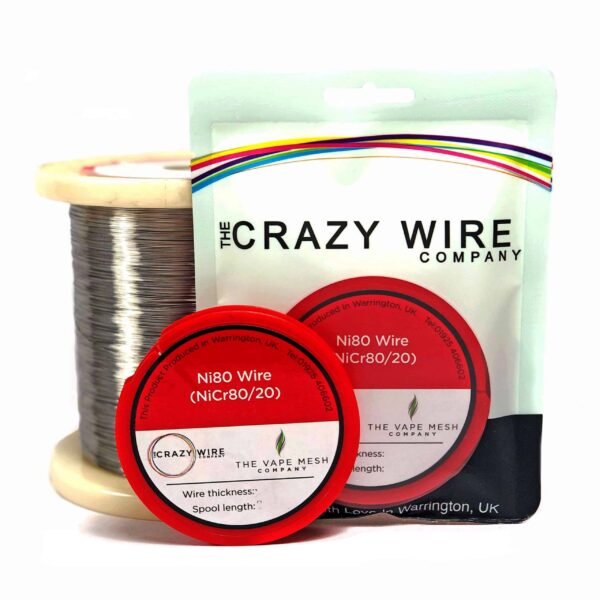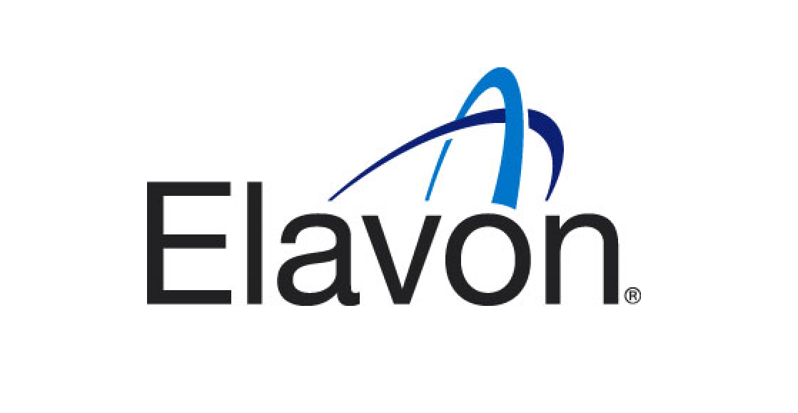Nichrome wire is an essential material for a wide range of applications, renowned for its resistance to high temperatures and excellent electrical properties.
In this guide, we will explore the many uses of 1mm nichrome wire, its unique benefits, alternative materials, and a detailed pros and cons chart to help you determine if it’s the right choice for your project.
1mm thickness nichrome is one of our most popular wires. We hope that this blog will help you to decide if this is the right wire for your project.
What is Nichrome Wire?
Nichrome, short for nickel-chromium, is an alloy composed primarily of nickel (60%-80%) and chromium (20%-40%), with occasional small amounts of iron or other elements. This alloy is prized for its ability to resist oxidation, corrosion, and extreme heat.
The 1mm diameter nichrome wire offers a balance of flexibility, strength, and thermal capacity, making it suitable for a diverse array of applications in industries such as heating, electronics, and crafting.
Key Properties of 1mm Nichrome Wire
- High Melting Point: Nichrome wire can withstand temperatures up to 1,400°C, making it ideal for high-heat applications.
- Electrical Resistance: It provides consistent and reliable resistance, perfect for use in heating elements and resistors.
- Corrosion Resistance: The chromium content ensures that the wire can resist oxidation and corrosion even at elevated temperatures.
- Durability: With proper use, nichrome wire retains its properties over time, offering long-term performance.
- Flexibility: Despite its high strength, nichrome wire can be bent and shaped to fit custom applications.
Top Uses for 1mm Nichrome Wire
1. Heating Elements
Nichrome wire’s ability to generate and maintain high temperatures makes it the go-to material for heating elements in:
- Toasters
- Hairdryers
- Electric ovens
- Industrial furnaces
- Space heaters
The wire heats evenly and retains its strength, ensuring consistent performance in high-demand environments.
2. Resistance Wire Applications
Its electrical resistance makes nichrome wire indispensable for:
- Resistors in electronic circuits
- Precision heating tools like soldering irons
- Voltage regulators
3. DIY and Crafting Projects
Creative hobbyists use nichrome wire for:
- Foam cutting
- Clay sculpting tools
- Pyrography (wood burning)
The wire can be shaped into custom configurations, enabling precise work in artistic and functional projects.
4. Industrial Processes
In industries, nichrome wire is commonly used for:
- Heat sealing machines
- Kilns for pottery or glasswork
- Vapour deposition systems
5. Medical and Scientific Equipment
Nichrome’s properties are also valued in:
- Sterilisation equipment
- Laboratory heating tools
- Specialised sensors
Benefits of 1mm Nichrome Wire
1. High Heat Resistance
Nichrome wire maintains its strength and conductivity at temperatures that would compromise other materials. This makes it ideal for prolonged use in extreme conditions.
2. Consistent Electrical Properties
The wire’s predictable resistance levels ensure reliability in electronic circuits and heating systems, reducing maintenance needs.
3. Longevity
With its resistance to oxidation and corrosion, nichrome wire outlasts many alternative materials, offering cost-effectiveness over time.
4. Versatility
Its ability to be shaped and adapted to various applications makes it a versatile choice for manufacturers and DIY enthusiasts alike.
5. Safety
Nichrome wire does not emit harmful gases when heated, making it safer to use in both industrial and household settings.
Alternatives to Nichrome Wire
Although nichrome wire is a top choice for many applications, there are scenarios where alternative materials might be considered:
1. FeCrAl Wire
- Composition: An alloy of iron, chromium, and aluminium.
- Advantages: Higher maximum operating temperature than nichrome and lower cost.
- Disadvantages: Less flexible and slightly lower resistance stability.
2. Stainless Steel Wire
- Composition: Iron alloy with chromium and nickel.
- Advantages: Superior corrosion resistance in non-heating applications.
- Disadvantages: Not as efficient for heating elements due to lower resistance.
3. Copper Wire
- Composition: Pure copper.
- Advantages: Excellent conductivity for electrical applications.
- Disadvantages: Poor heat resistance and higher susceptibility to oxidation.
4. Tungsten Wire
- Composition: Pure tungsten.
- Advantages: Extremely high melting point.
- Disadvantages: Expensive and brittle, limiting its versatility.
Pros and Cons of 1mm Nichrome Wire
| Pros | Cons |
|---|---|
| High heat resistance | Higher cost compared to some materials |
| Excellent corrosion resistance | Requires specific tools to cut |
| Long-lasting and durable | Limited availability in certain regions |
| Flexible and easy to shape | Less conductive than copper |
| Consistent and reliable performance | May not be suitable for low-resistance applications |
| Non-toxic and safe for various uses |
How to Choose the Right Nichrome Wire for Your Project
When selecting nichrome wire, consider these factors:
- Temperature Requirements: Ensure the wire can withstand the heat levels needed for your application.
- Wire Diameter: Larger diameters like 1mm offer greater strength and durability, ideal for heavy-duty uses.
- Resistance Levels: Check the resistance rating to match your electrical or heating needs.
- Environment: For outdoor or high-humidity environments, nichrome’s corrosion resistance is a significant advantage.
Tips for Working with Nichrome Wire
- Cutting: Use specialised wire cutters designed for strong alloys.
- Joining: To join nichrome wires, consider spot welding or using crimp connectors, as soldering may not work due to the high melting point.
- Shaping: Wear gloves to prevent hand fatigue when bending thicker wires like 1mm.
- Safety: Always follow safety guidelines when working with heated nichrome wire, especially in DIY projects.
Available Nichrome Wire Options:
| Ni80 | Ni80 | Ni90 | Ni90 | Ni60 | Ni60 |
| Diameter (mm) | AWG | Diameter (mm) | AWG | Diameter (mm) | AWG |
| 0.05 | 44 | ||||
| 0.06 | 42 | ||||
| 0.07 | 41 | ||||
| 0.08 | 40 | 0.08 | 40 | ||
| 0.09 | 39 | ||||
| 0.1 | 38 | 0.1 | 38 | ||
| 0.12 | 36 | ||||
| 0.125 | 36 | ||||
| 0.13 | 36 | 0.13 | 36 | ||
| 0.14 | 35 | ||||
| 0.15 | 35 | ||||
| 0.16 | 34 | ||||
| 0.17 | 34 | ||||
| 0.18 | 33 | ||||
| 0.2 | 32 | 0.2 | 32 | ||
| 0.21 | 32 | ||||
| 0.23 | 31 | ||||
| 0.25 | 30 | 0.25 | 30 | 0.25 | 30 |
| 0.27 | 29 | ||||
| 0.28 | 29 | ||||
| 0.29 | 29 | ||||
| 0.3 | 29 | 0.3 | 29 | ||
| 0.32 | 28 | 0.32 | 28 | 0.32 | 28 |
| 0.35 | 28 | ||||
| 0.37 | 27 | 0.37 | 27 | ||
| 0.38 | 27 | ||||
| 0.4 | 26 | 0.4 | 26 | 0.4 | 26 |
| 0.42 | 26 | ||||
| 0.45 | 25 | 0.44 | 25 | ||
| 0.5 | 24 | 0.5 | 24 | 0.5 | 24 |
| 0.54 | 23 | ||||
| 0.6 | 22 | 0.6 | 22 | ||
| 0.64 | 22 | 0.64 | 22 | ||
| 0.7 | 21 | 0.72 | 21 | ||
| 0.8 | 20 | 0.81 | 20 | 0.8 | 20 |
| 0.9 | 19 | 0.9 | 19 | 0.9 | 19 |
| 1 | 18 | ||||
| 1.15 | 17 |
1mm nichrome wire is a versatile, durable, and reliable material, ideal for a wide range of applications from industrial heating to creative projects. Its resistance to high temperatures and corrosion ensures long-lasting performance, while its flexibility allows for customised use in countless scenarios.
Although alternative materials like FeCrAl or stainless steel may be suitable in some cases, nichrome wire’s unique properties often make it the superior choice.
When considering your next project, be it crafting, heating, or industrial, 1mm nichrome wire offers the perfect blend of performance and adaptability. Explore the possibilities and discover how this remarkable material can elevate your work to the next level.
For more on nichrome wire and other high-quality materials, check out our full range here.
We offer also a massive range of stainless steel wire and nichrome wire through our store. Choose the wire that you want to work with and we’ll get spooling.
If you’re interested in learning more about wire, check out our other blog on Everything You Need to Know About Wires.
We are also proud to supply this product on our highly popular eBay store, check us out there too.
Thank you for checking out our site.
- MULTIBUY SAVINGS – ORDER 5 FOR 20% OFF
- FREE UK Delivery For All Orders Over £25
- Immediate Express Dispatch From Stock
- Orders Fulfilled From Warrington, UK
- Tracked Delivery with Order Updates
- 30-Day Unused Returns Accepted



